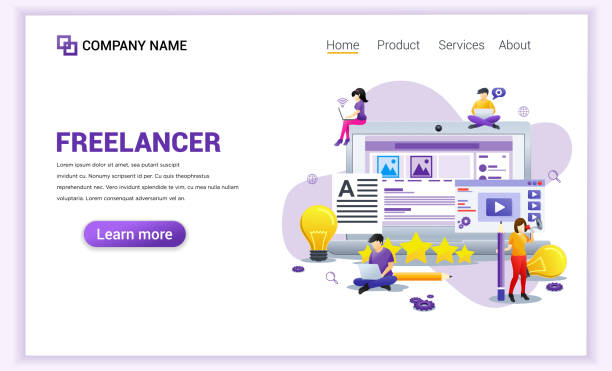Introduction to the Dynamic World of Web and the Importance of #Responsive_Website_Design

In today’s world, where technology is advancing at an incredible speed and users access the internet from various devices, #responsive_website_design is no longer a luxury option, but a vital necessity.
From smartphones with small screens to tablets, laptops, and even large smart TVs, websites must be able to display their content optimally and legibly at any size.
This approach, also known as #responsive_design, ensures that the user experience (UX) remains seamless and satisfying regardless of the device type.
Ignoring this principle not only leads to loss of visitors but can also severely impact the site’s SEO ranking and push businesses out of competition.
The goal of this article is to deeply examine various aspects of this field and provide comprehensive guidance for web professionals.
Is your current e-commerce website design not generating the sales you expect?
RasaWeb specializes in professional e-commerce website design!
✅ Attractive and user-friendly site aimed at increasing sales
✅ High speed and security for an ideal shopping experience⚡ Get a free consultation for online store design with RasaWeb!
Fundamental Principles of Responsive Design and its Key Components

Responsive website design is based on three main pillars: Fluid Grids, Flexible Images, and Media Queries.
Fluid grids mean that the website layout is defined using percentages instead of fixed pixels, to easily adapt to screen size changes.
This approach ensures that page elements always adjust themselves relatively to each other and to the size of their display.
Flexible images follow the same rule; they are set using CSS and max-width (max-width: 100%) so they never overflow their container and are always displayed at the appropriate size.
Finally, media queries are powerful tools in CSS3 that allow developers to apply different styles based on device characteristics (such as screen width, height, orientation, and resolution).
These three components together form the skeleton of a truly responsive website, capable of intelligently adapting to various user environments and providing a flawless user experience.
Technical Aspects of Responsive Design: From Media Queries to Adaptive Images

For effective implementation of responsive website design, a deep understanding of its technical aspects is essential.
Media Queries are the core of this process.
They allow the developer to define specific CSS rules for different screen width ranges.
For example, one can specify that for widths less than 768 pixels, the navigation menu should transform into a hamburger icon or font sizes should decrease.
This capability allows the designer to optimize the user experience for each device.
Additionally, Fluid Grids, by using relative units like percentages instead of fixed pixels, ensure that the layout continuously adapts to the screen size.
This flexibility allows page elements to easily resize without disrupting the layout.
Flexible Images also adapt to their parent container by setting their width (width: 100%) and max-width (max-width: 100%) to prevent overflow or excessive shrinking.
These three elements form the foundation for building a modern and accessible website, allowing the website to look great on any device.
The table below lists some common Breakpoints and their applications:
| Device Type | Approximate Width (pixels) | Description |
|---|---|---|
| Smartphone (Small) | Up to 320 pixels | Display content in a single column, larger fonts for readability |
| Smartphone (Regular) | 320 to 480 pixels | Still one column, optimized for touch |
| Tablet (Portrait) | 481 to 768 pixels | Two columns or layout changes for elements |
| Tablet (Landscape) and Small Laptop | 769 to 1024 pixels | Multiple columns, fuller menus |
| Desktop | 1025 pixels and above | Full website layout |
User Experience (UX) and the Impact of Responsive Design on Audience Satisfaction

Responsive website design is not just a technical requirement, but the backbone of a successful user experience (UX).
In today’s age, where users expect to access information anytime and anywhere, a website that does not display correctly on different devices will quickly be abandoned by the audience.
A poor user experience not only leads to a high bounce rate but also directly negatively impacts brand credibility and conversion rates.
Responsive websites enhance user loyalty by providing a seamless and optimized experience, regardless of the device type.
This includes ensuring text readability, easy clickability of buttons and links, and intuitive navigation at any screen size.
From a user’s perspective, a responsive website means reduced friction in accessing content and increased overall satisfaction.
This analytical approach shows that investing in responsive design is a direct investment in increasing customer satisfaction and ultimately business success.
Are you losing customers because of your e-commerce site’s outdated appearance or slow speed? RasaWeb’s expert team will solve these problems with professional e-commerce website design!
✅ Increase customer trust and your brand’s credibility
✅ Stunning speed and excellent user experience
Get a free consultation with RasaWeb right now ⚡
Popular Tools and Frameworks for Implementing Responsive Design

To facilitate the responsive website design process, numerous tools and frameworks have been developed that make the work much easier for designers and developers.
Bootstrap, as one of the most popular front-end frameworks, provides a powerful grid system and ready-to-use UI components, enabling fast and efficient creation of responsive websites.
This framework, with its “mobile-first” approach, is designed from the outset to meet the needs of various devices.
Tailwind CSS is another option that, with its Utility-First approach, allows developers to quickly implement responsive styles with small, composable classes.
In addition to frameworks, browser development tools (Developer Tools) in Chrome, Firefox, and other browsers are also crucial for simulating different devices and testing website responsiveness.
Using these tools accelerates the design process and identifies potential errors before public release.
These guiding and educational approaches are important steps towards mastering modern web design.
Performance and Speed Issues in Responsive Websites

One of the significant challenges in responsive website design is maintaining optimal performance and loading speed.
Websites that are not properly optimized may have long loading times on mobile devices with slow internet, severely disrupting the user experience.
To counter this problem, image optimization (compression and use of modern formats like WebP), lazy loading (Lazy Loading) for images and videos, and Gzip compression for CSS and JavaScript files are of high importance.
Also, using a CDN (Content Delivery Network) to deliver content faster to users worldwide can have a significant impact.
A successful responsive design must be flawless not only in appearance but also in performance, so that users enjoy a smooth and fast experience.
This analytical section highlights the importance of performance optimization alongside aesthetics.
Common Challenges and Solutions in Responsive Design

Despite numerous advantages, implementing responsive website design can come with challenges.
One such challenge is managing CSS complexities for correct display at all sizes.
Sometimes, overlooking a specific breakpoint (Breakpoint) can lead to layout issues on certain devices.
Another challenge is optimizing images for different devices; using high-resolution images for desktop displays can cause slow loading on mobiles.
The solution to this problem is to use adaptive images with the `
Testing the website on actual devices, not just simulators, is also crucial for identifying unexpected issues.
This section provides practical guidance for dealing with common problems.
The table below lists some common problems and their suggested solutions:
| Challenge | Explanation | Solution |
|---|---|---|
| High-volume Images | Reduced loading speed on mobile | Compression, WebP format, Lazy Loading, srcset/picture |
| Complex Navigation Menus | Difficulty of use on small screens | Hamburger menu, dropdown menu, bottom bar navigation for mobile |
| Long and Complex Forms | Problem filling out on mobile | Optimized keyboards, field separation, autofill capability |
| Insufficient Testing | Hidden bugs on specific devices | Testing on actual devices, using online responsive testing tools |
| Excessive Content | Takes up too much space, difficulty in navigation | Content prioritization, using accordions or tabs for secondary content |
The Future of Responsive Website Design and Emerging Trends

The future of responsive website design extends beyond merely adapting to different screen sizes.
With the advent of technologies such as flexible displays, wearable devices, and even voice user interfaces, the concept of responsiveness has expanded to mean adapting to the user environment and context.
Approaches like “Adaptive Design,” which changes layout based on specific breakpoints rather than continuous flexibility, alongside “Atomic Design,” which emphasizes building small, reusable components, indicate the evolution of this field.
Furthermore, the increasing use of Voice User Interfaces and the importance of Accessibility for individuals with different abilities, have added new dimensions to responsive design.
News regarding updates to Google’s algorithms consistently emphasize the importance of mobile user experience, indicating that responsive web design will remain a focal point.
This analytical and entertaining look into the future addresses questions about how the web will evolve in the coming years.
Did you know 85% of customers check your company’s website before any interaction?
With RasaWeb, build a corporate website worthy of your credibility.
✅ Increase customer trust and brand credibility
✅ Attract high-quality leads
⚡ Get a free website design consultation
Beyond Resizing: Content Strategy for Responsive Design

Responsive website design is not just about changing the layout of elements based on screen size; it’s a comprehensive approach to managing and delivering content optimally in every user context.
The question here is: Should all website content be displayed the same way on all devices? The answer is often no.
Content strategy in responsive design means content prioritization.
This means deciding which information is most essential for mobile users and how to present it concisely, while additional information remains available for desktop users.
For example, a complex data table might be displayed as summary cards or simpler charts on mobile.
This approach requires critical thinking and asks developers and designers to consider not only the appearance but also the purpose and utility of each piece of content on different devices.
This thought-provoking and analytical content section provides a deeper look into the non-technical but crucial aspects of this field.
Conclusion: The Inevitable Necessity of Responsive Website Design in the Digital Age

In conclusion, it is clear that responsive website design is no longer a competitive advantage, but an industry standard and a prerequisite for survival in the modern web world.
With the ever-increasing number of mobile users and the diversity of internet-connected devices, websites that cannot provide a seamless and optimized user experience across every platform will rapidly lose market share and visitors.
A responsive website not only improves your SEO ranking and reduces bounce rate, but also directly impacts customer satisfaction and your brand image.
Investing in responsive design is an investment in the future of your business and ensures wider audience access to your valuable content.
This explanatory and analytical approach provides a final emphasis on the importance of this concept in today’s digital space.
Frequently Asked Questions
| Question | Answer |
|---|---|
| What is responsive website design? | A web design approach that automatically adjusts and optimizes the layout and content of a website for display on various devices (mobile, tablet, desktop). |
| Why is responsive design important? | Due to the variety of devices users employ to access the web; it offers a better user experience, stronger SEO, and reduces user bounce rate. |
| What are the main techniques in responsive design? | Using Media Queries in CSS, Fluid Grids, and Flexible Images. |
| What is a Media Query? | A CSS rule that allows you to apply different styles based on device characteristics (such as screen width, height, display orientation). |
| Is responsive design different from Mobile-First design? | Mobile-First is an approach within responsive design that initially designs the site for the smallest screen (mobile) and then progressively enhances it for larger screens. |
And other advertising services of RasaWeb advertising agency
Smart Sales Automation: A novel service for increasing sales through marketing automation.
Smart Marketplace: A fast and efficient solution for campaign management focusing on marketing automation.
Smart SEO: An effective tool for user engagement through custom programming.
Smart Advertorial: Professional optimization for increasing click-through rates using real data.
Smart Social Media: Professional optimization for digital branding using key page optimization.
And over hundreds of other services in internet advertising, advertising consultation, and organizational solutions
Internet Advertising | Advertising Strategy | Advertorial
Sources
The Future of Responsive Design in IranThe Evolution of Responsive Design and Its FutureThe Role of Web in the Future of BusinessesFuturism in Web Development
? Ready to revolutionize your business in the digital world? RasaWeb Digital Marketing Agency, with expertise in various fields including professional website design, SEO, and social media management, paves the way for your growth and success.
📍 Tehran, Mirdamad Street, next to Bank Markazi, Kazeroun Jonoubi Alley, Ramin Alley No. 6



